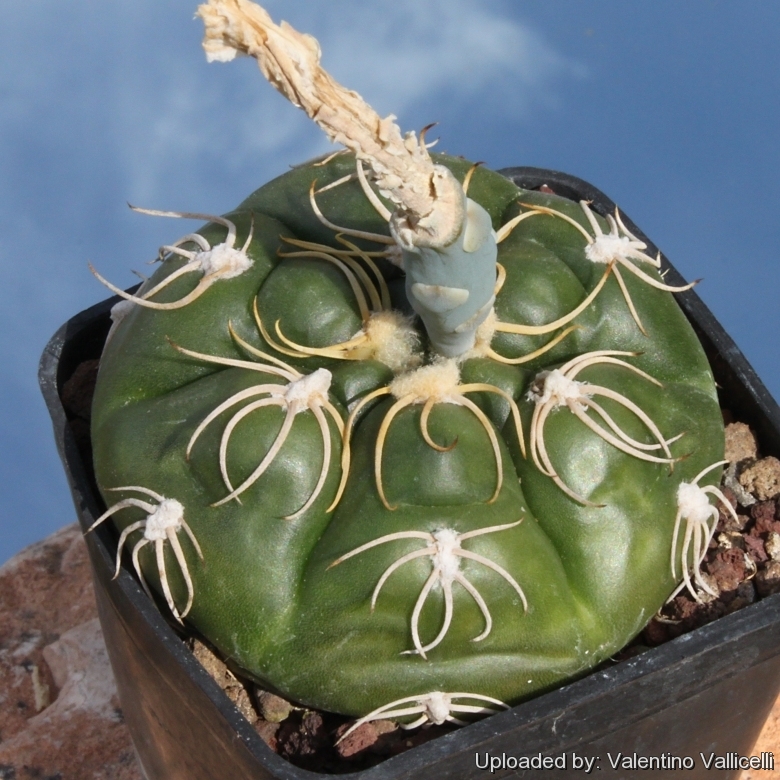
Gymnocalycium denudatum Photo by: Valentino Vallicelli
This species has nearly armless spines flattened against body ,
looking like a bunch of white spiders crawling on a cactus.
Origin and Habitat: Southern America, Brazil (Rio Grande do Sul), Argentina (Corrientes, Misiones) Paraguay [possibly] and Uruguay.
Synonyms:
See all synonyms of Gymnocalycium denudatum
back
Accepted name in llifle Database:Gymnocalycium denudatum (Link & Otto) Pfeiff. ex MittlerTaschenb. Cactuslieb. 2ed.: 48 +124 (1844) [ et Pfeiff. in Pfeiff. & Otto, Abbild. & Beschr. Bluh. Cact. ii. sub t. 1 (1845), in adnot. ]Synonymy: 14
Accepted name in llifle Database:Gymnocalycium denudatum subs. angelae (Mereg.) PrestléGymnocalycium 17(2): 577. 2004 [May 2004]Synonymy: 2
Accepted name in llifle Database:Gymnocalycium denudatum subs. angulatum PrestléGymnocalycium 17(2):573, 2004
Accepted name in llifle Database:Gymnocalycium denudatum var. anisitsii hort., Kreuz.Verzeichnis Amer. Sukk. Rev. Syst. Kakteen 13, 1935
Accepted name in llifle Database:Gymnocalycium denudatum var. argentinense F.HaageKakteen-Peisverzeichnis: 14, 1928
Accepted name in llifle Database:Gymnocalycium denudatum var. argentinense Y.ItôCactaceae [Itô] 378, 1981 later omonym, nom. illeg. (Art. 53.1)
Accepted name in llifle Database:Gymnocalycium denudatum var. backebergii PazoutFriciana 3(15): 6, 1963, nom. inval. (Art. 37.1)
Accepted name in llifle Database:Gymnocalycium denudatum var. boliviensis hort.Catalog name. Pubbl. in Schneekloth List
Accepted name in llifle Database:Gymnocalycium denudatum var. brachyanthum hort.Catalog name. Pubbl. in Schneekloth List
Accepted name in llifle Database:Gymnocalycium denudatum var. brasiliensis hort.Catalog name. Pubbl. in Uhlig seed list 1992/93
Accepted name in llifle Database:Gymnocalycium denudatum var. flavispinum (Mundt in Schelle) Y.Itô170, 1957 nom. inval. (Art. 33.2)Synonymy: 2
Accepted name in llifle Database:Gymnocalycium denudatum var. grandiflorum hort.Catalog name. Pubbl. in Schneekloth List
Accepted name in llifle Database:Gymnocalycium denudatum var. montanum subv. staminosum PrestléManuskript und Protokoll, Eugendorf n.n. 1996
Accepted name in llifle Database:Gymnocalycium denudatum var. montanum PrestléManual (Gray), ed. 2. n.n. 1996
Accepted name in llifle Database:Gymnocalycium denudatum subs. necopinum Prestlé17(2):575, 2004
Accepted name in llifle Database:Gymnocalycium denudatum var. necopinum Prestlén.n. 1996
Accepted name in llifle Database:Gymnocalycium denudatum var. pentacanthum hort.published in Uhlig Catalogue n.n. (= horstii?)
Accepted name in llifle Database:Gymnocalycium denudatum var. roseum Hildm.Atlas Kaktusu 15, 1986Accepted name in llifle Database:Gymnocalycium denudatum var. terwinianum hort.Catalogname, published in Schneekloth-Liste
Cultivars
(1):
back
Common Names include:
ENGLISH: Spider Cactus (Referring to the shape of the spider-like spines)
Description: Gymnocalycium denudatumSN|7888]]SN|7888]] is a small globular, usually unbranched, cactus with glossy dark-green body and rounded ribs. Gymnocalycium denudatumSN|7888]]SN|7888]] is extremely variable.
Stem: Solitary, broadly globular, depressed globose or subglobose, 2-3 cm tall and 6-8 cm in diameter ( up to 10 cm tall 15 cm in diameter in cultivation) glossy greyish-green to dark green.
Ribs: Usually 5, occasionally up to 8, flat, with poorly developed tubercles (The 'chin' effect is not as visible as in other Gymnocalyciums).
Tubercles: Broad and low
Areoles: Few roundish, slightly woolly 1-2 cm apart.
Spines: All radials, spider-like, nearly harmless, 1-1,5 cm long, white or pale rose coloured, awl-shaped, slender, curved laterally or upward, somewhat twisted or bent and closely appressed against body.
Flowers: Large shiny cream white sometime very pale rose-coloured , up to 5 cm long and 7 cm wide. Perianth segments oblong, acute. Pericarpel and flower-tube with occasional acute scales.
Blooming season: In spring and summer.
Fruits: Oblong, green.
More...Bibliography: Major references and further lectures
1) James Cullen, Sabina G. Knees, H. Suzanne Cubey “The European Garden Flora Flowering Plants: A Manual for the Identification of Plants Cultivated in Europe, Both Out-of-Doors and Under Glass” Cambridge University Press, 11/Aug./2011
2) David Hunt, Nigel Taylor “The New Cactus Lexicon” DH Books, 2006 ISBN 0953813444, 9780953813445.
3) Edward F. Anderson “The Cactus Family” Timber Press, 2001
4) N. Gerloff and D. Metzing in: “Kakteen und andere Succulenten” 53 (2): 29-39 2002
5) N. Gerloff and D. Metzing in Russian: “Kaktus-Klub” 2:35-44 2002
More...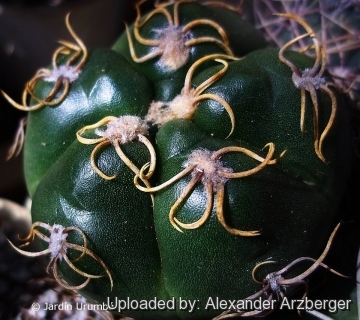 Gymnocalycium denudatum Photo by: Alexander Arzberger
Gymnocalycium denudatum Photo by: Alexander Arzberger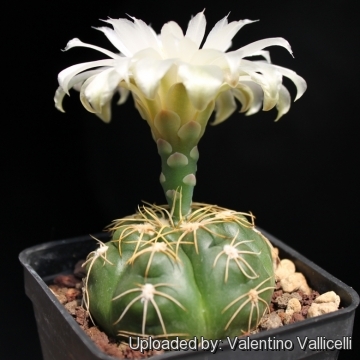 Gymnocalycium denudatum Photo by: Valentino Vallicelli
Gymnocalycium denudatum Photo by: Valentino Vallicelli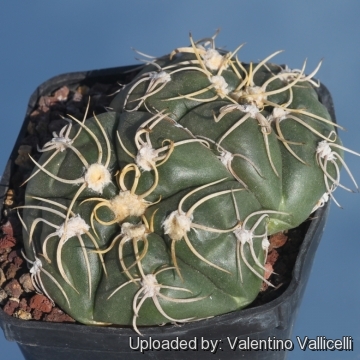 Gymnocalycium denudatum Photo by: Valentino Vallicelli
Gymnocalycium denudatum Photo by: Valentino Vallicelli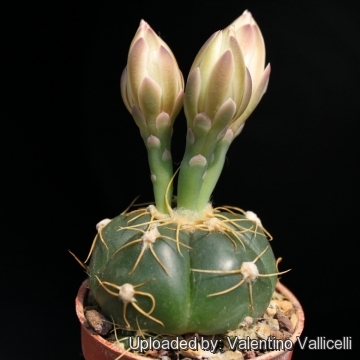 Gymnocalycium denudatum Photo by: Valentino Vallicelli
Gymnocalycium denudatum Photo by: Valentino Vallicelli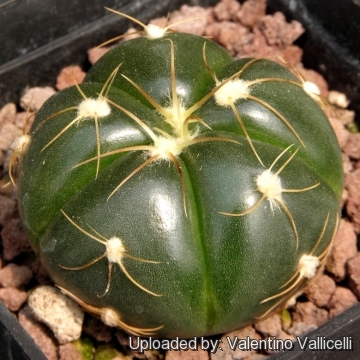 Gymnocalycium denudatum Photo by: Valentino Vallicelli
Gymnocalycium denudatum Photo by: Valentino Vallicelli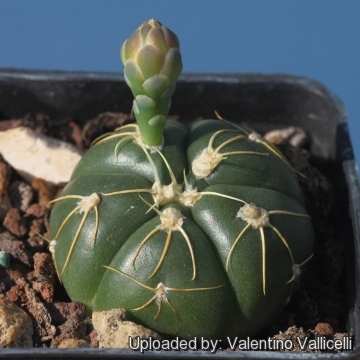 LB811 (Collector: C. A. Ludwig Bercht) Pedras Altas, 3km from Nototcactus scopa v. xicoi, Rio Grande do Sul, Brazil Photo by: Valentino Vallicelli
LB811 (Collector: C. A. Ludwig Bercht) Pedras Altas, 3km from Nototcactus scopa v. xicoi, Rio Grande do Sul, Brazil Photo by: Valentino Vallicelli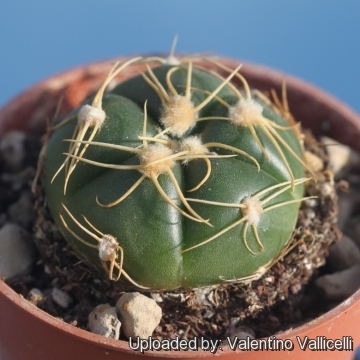 Gymnocalycium denudatum GF32 Cacapava do Sul to Lavras do Sul km 22, Rio Grande do Sul, Brazil. Photo by: Valentino Vallicelli
Gymnocalycium denudatum GF32 Cacapava do Sul to Lavras do Sul km 22, Rio Grande do Sul, Brazil. Photo by: Valentino Vallicelli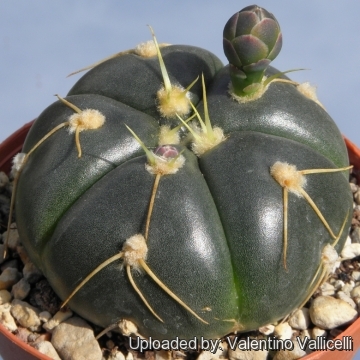 Locality: Artigas. Photo by: Valentino Vallicelli
Locality: Artigas. Photo by: Valentino VallicelliCultivation and Propagation: Gymnocalycium denudatumSN|7888]]SN|7888]] is a summer grower species that is easy to cultivate.
Growth rate: It is a relatively rapidly growing and easily flowering species.
Soils: It likes very porous standard cactus mix soil. Prefer a low pH compost, avoid substrata rich in limestone; otherwise growth will stop altogether.
Repotting: This plant needs plenty of space for its roots, repotting should be done every other year or when the it has outgrown its pot. Use pot with good drainage.
Watering: Needs moderate to copious waterings in summer, but do not overwater (Rot prone), keep dry in winter at a minimum temperature of 0°C.
Fertilization: Feed with a high potassium fertilizer in summer.
Hardiness: Reputedly resistant to light frost if kept on the dry side prior to, and during, cold weather (hardy to -2 C ° C, or less for short periods), but for safe cultivation it is best to avoid freezing temperatures.
Exposition: The plant tolerates extremely bright situations but enjoys filtered sunlight or afternoon shade, inside it needs bright light, and some direct sun. Tends to bronze in strong light, which encourages flowering and heavy spine production, but is likely to suffer from sun scorch or stunted growth if over exposed to direct sunlight during the hottest part of the day in summer.
Uses: It is an excellent plant for container growing. It always looks good and stays small. It look fine in a cold greenhouse and frame or outdoor in a rockery.
Pests & diseases: It may be attractive to a variety of insects, but plants in good condition should be nearly pest-free, particularly if they are grown in a mineral potting-mix, with good exposure and ventilation. Nonetheless, there are several pests to watch for:
- Red spiders: Red spiders may be effectively rubbed up by watering the plants from above.
- Mealy bugs: Mealy bugs occasionally develop aerial into the new growth among the wool with disfiguring results, but the worst types develop underground on the roots and are invisible except by their effects.
- Scales: Scales are rarely a problem.
- Rot: This species is particularly easy and accommodating, seldom suffer of cryptogamic diseases. Rot it is only a minor problem with gymnocalyciums if the plants are watered and “aired” correctly. If they are not, fungicides won't help all that much.
Propagation: Direct sow after last frost. Seeds germinate in 7-14 days at 21-27° C in spring, remove gradually the glass cover as soon the plants will be well rooted (ca 1-2 weeks) and keep ventilated, no full sun for young plants!
More...
Your Photos
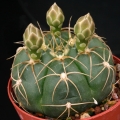
by Valentino Vallicelli




















